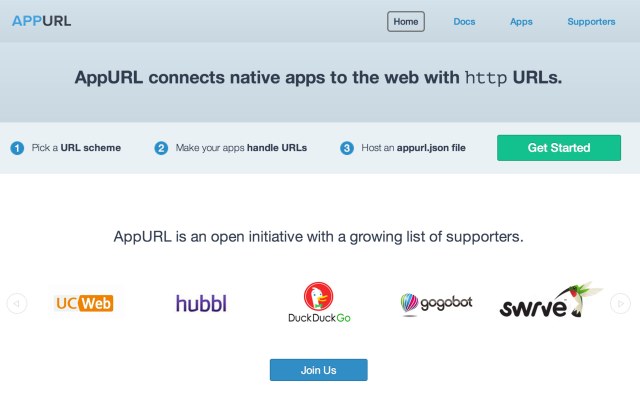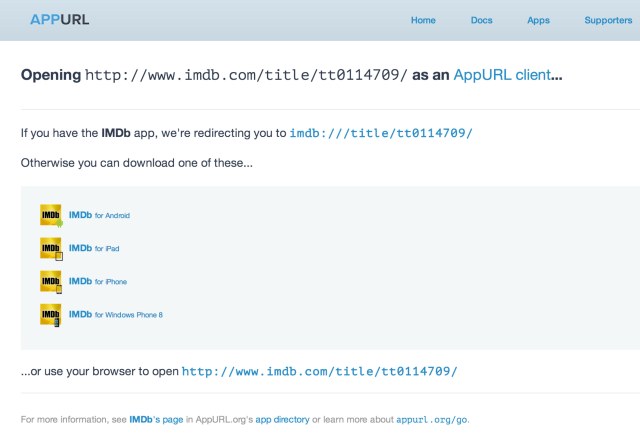Mobile app search engine Quixey is today introducing a new initiative called AppURL which proposes a way to make mobile apps work more like the web. Instead of apps existing as standalone silos, AppURL would allow users to navigate from one app directly to a specific piece of content found in another – like an article within a news application, a restaurant listing on Yelp, or a particular friend’s profile in a social app, for example.
This concept is called “deep linking,” and it’s not an altogether new one. There have been a few attempts to kickstart its adoption in the industry before, most recently with the debut of Cellogic’s new service called Deeplink.me, which is essentially a bit.ly for mobile app deep linking. Earlier efforts have also included things like OneMillionAppSchemes.com, a database that tried to open source the unpublished custom URL schemes for iOS applications, and PhotoAppLink, an older open source initiative aiming to simplify photo editing by tying multiple photo-editing apps together using similar app-linking technology. (I’ve personally advocated for deep linking myself, I have to note.)
“The idea for deep linking isn’t necessarily new,” agrees Quixey co-founder and CEO Tomer Kagan. “Twitter has their cards,” he says, referring to Twitter’s push to have developers publish additional HTML on their webpages in order to create more media-rich tweets. “And other companies have their own proprietary schemes. But we’re saying that not every company should redevelop their own way of doing this. There should be a universal way of doing this – a universal initiative that everyone gets behind that doesn’t benefit one person over the other.”
So, why then, is Quixey pushing out its own ideas instead of allowing the developer community to more jointly and collaboratively agree upon the process, then put it to use? Frankly, says Kagan, because no one has done that yet. And it’s been years.
“When Liron [Shapira, Quixey CTO] and I started Quixey over three years ago, we discussed a concept exactly like AppURL, and said ‘wouldn’t it be great if something like this existed?’,” Kagan explains. But they didn’t take further steps to progress the idea externally, because they just assumed it would happen on its own. “Us putting this out there is more like us saying, ‘Really? People didn’t get their act together?’,” he says.
As with the efforts from Celllogic on Deeplink.me, the AppURL initiative emerged from other things the company was already working on – in Quixey’s case, its app search service which partners like Ask.com, Microsoft, Sprint, Nokia, and others use to power their own app search offerings. However, unlike with Deeplink.me, Quixey is not interested in turning AppURL into another business.
“We think deep linking is vital to the ecosystem in general. We don’t think it’s something any one company should own, exclusively monetize, or have control over,” Kagan says. Instead, Quixey is just publishing how they’re doing things, since they’ve heard from a lot of developers that theirs is a more elegant solution than how some others are hacking around the problem, and hoping that the community will agree and adopt the idea.
How It Works
Here’s how AppURL works, in three steps:
The first step is for an app developer to pick a URL scheme for their app. The second step is make their apps handle URLs. And the third step is to publish an appurl .json file, which is basically machine-readable documentation that explains how an app is connected is connected to the http web.
By doing so, not only does the system enable app deep linking, it also makes its possible for search engines to crawl in-app links – an engine can do an http request to a URL that’s in an app, and index the information that comes out. (Of course, given that Quixey is in the app search business itself, getting everyone to adopt AppURL would mean that its core business could improve, even if it’s not monetizing AppURL directly, we should point out.)
Quixey has also set up an AppURL redirection service at appurl.org/go, which is the easiest way to link to an AppURL-enabled app. When you click one of these appurl.org/go links, the link will redirect you to the app on your mobile device (Android, iPhone, iPad, Windows Phone, Blackberry, etc.) if you have it installed, or to the website if you do not.
But, explains Quixey CTO Liron Shapira, the AppURL service is there for convenience’s sake. The better way for developers to use AppURL is to host their own JavaScript redirect on their own website – that would allow them to use the AppURL scheme without having to use appURL.org/go at all.
All the details on how developers can take advantage of AppURL are documented on the AppURL.org website.
At launch, a handful of mobile app developers and other industry folks have announced support for AppURL, including DuckDuckGo, Gogobot, hubbl, Swrve, Blekko, Appurify, and UCWeb. Quixey has also set up a database of appurl.json files to help developers deep link within popular apps like Ebay, Evernote, Flixster, Foursquare, IMDb, Instagram, Pandora, Skype, Spotify, Twitter, Yelp, Wolfram Alpha, and others. Developers can submit their own apps to this directory here.
Making it just as easy to move from a website to an app, or app to app, or from an app to the web, may not be something that those benefiting from the closed ecosystem today, like Apple, would want to see happen. But the open web can be a powerful force – one that even Apple may not be able to control forever.


